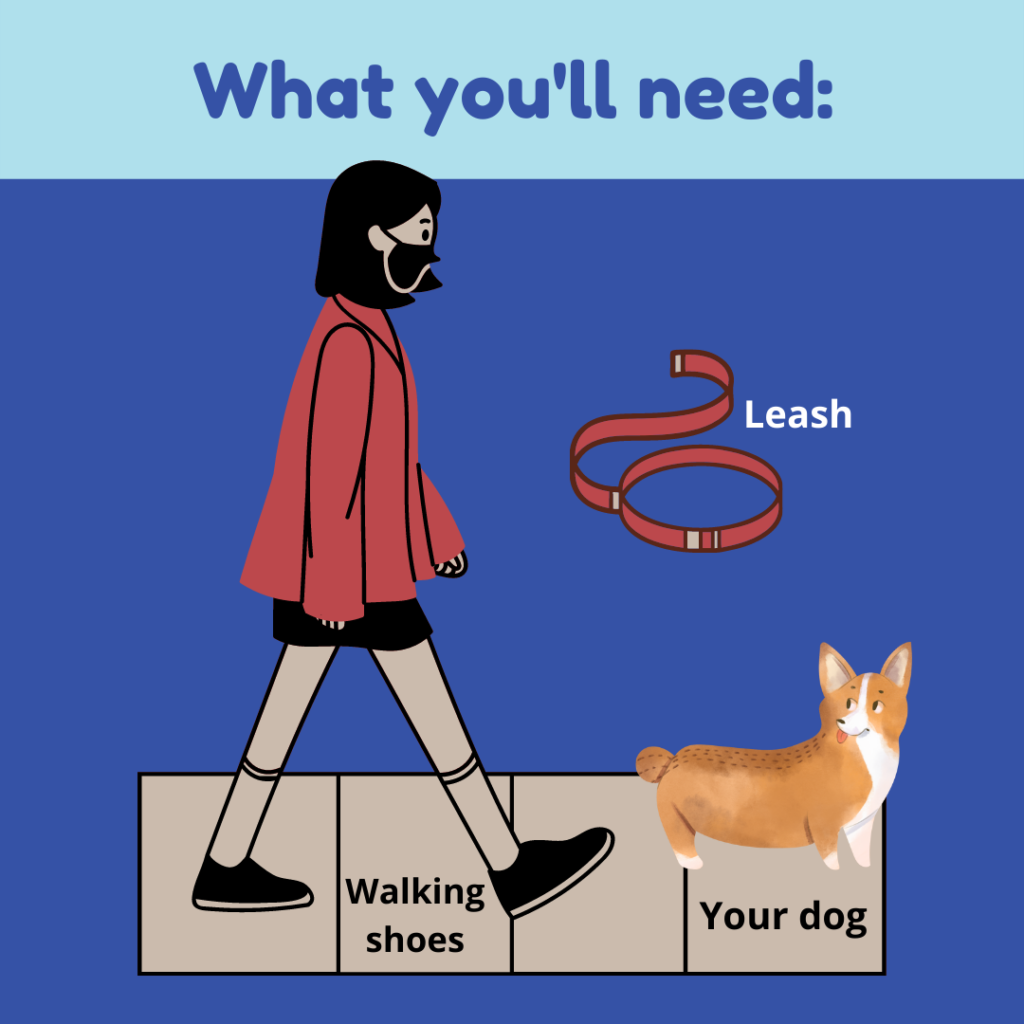Do you want to be one of those incredibly confident dog owners that can stroll down the street without your dog barking, lunging, pulling, and causing a scene? You can! And you don’t have to hire a dog trainer to get started. You may want to, but you don’t HAVE to. And we’re going to show you how with this simple drill that we lovingly call “Driveway Drills”.

Understanding Why Your Dog Pulls on Leash
Alright, so before you get started, let’s break down what is happening on leash. Currently, you’re struggling to walk your dog. It could be because she wants to sniff every wonderful smell, or because she is reactive and loses her mind when she sees another dog, or perhaps she’s afraid of her own shadow and would rather stay inside. I hate to say it, but the reason your walk isn’t working doesn’t really matter. Not yet, at least. We’ll definitely need to work through those specific behaviors down the road, but first we need to reset your dog’s relationship with the leash.
So right now, when you walk outside with your pup, she sees the leash (and therefore you) as an annoyance. You are keeping her from doing what she currently wants to do (sniff, run, play, bark at the neighbor, etc.). And that causes a lot of frustration for her. So to deal with that frustration, she is choosing to pull harder on that leash to show you exactly where she wants to go. And she’s going to keep pulling until she gets what she wants (or until you force her toward a different path). It’s an incredibly unhealthy relationship that she has with the leash, and by extension, you.
That needs to change. ASAP. It’s not fun for anyone to have their arm pulled for an entire walk. So we’re going to help you reset that relationship. We want to show your dog that every time she feels pressure on the leash, it means she’s gone too far, and she needs to return back to your side. And we want to show you that you are exactly the right person to help her through this. Sound hard? It’s not, as long as you’re ready to be patient and consistent.
Getting in the Right Mindset Before You Begin
Before you start training your dog to walk on leash (and any skill, really), it’s important that you are in the right mindset. Most dog owners see a leash and are instantly reminded of the terrible, stressful, overwhelming walks that they’re used to. You have a negative association with the leash, and you probably don’t enjoy walks very much right now.
We want to ask you to set aside those feelings, as hard as it may be. In order to properly lead your dog into this new way of walking on leash, you need to be a calm and confident leader. You may not feel it right now, but you can probably fake it pretty well if you have to. At least at first. So before you even grab that leash, take a deep breath, tell yourself you are in control of this situation, and that you have the ability to change your walks.
This confidence and sense of calm WILL rub off on your dog. Energy runs through your leash, whether you realize it or not. If you are anxious, holding that leash tightly, on edge at every turn, your dog is going to feel that nervous energy. And she’s going to think that there is a reason to be concerned. “Mom’s worried. Something must not be right. I need to be ready for whatever comes our way!” And BAM, you have a nervous dog that is ready to react to anything in her path.
But if you’re calm, holding the leash loosely by your side with your shoulders relaxed, you are telling your pup that you have control of this situation. She’ll then start thinking, “Huh, mom is super chill right now. She doesn’t seem worried about anything. I’m going to trust that she has control here.” Just like that, you’ve passed your calm energy on to your dog and told her that this walk is going to be different. And that’s before we even start walking!
What You’ll Need

- Leash
- Walking shoes
- Driveway (or quiet space with minimal distractions)
- Your dog!
Driveway Drills: What Are They?
Driveway drills are your key to a new, happy walk with your pup. It may be easier for us to show you before we explain it, so take a look at this short clip of us working with one of our training dogs, Annie:
Looks easy, right? Maybe even a little boring? But we promise you, there is magic in this drill. And it works with about 99% of dogs that we train, which is why we want you to give it a shot.
So have your dog on leash and find a nice, quiet spot where you won’t be bothered by a lot of distractions. We like the driveway (hence the very creative name for this drill). Now start moving forward. As soon as your dog starts moving past you, change your direction and walk the other way. Your dog will likely hit the end of the leash, realize that you’re walking away, and trot to catch up to you… and then likely run past you again. As soon as she runs past, turn and walk the other way again.
Repeat this until your dog starts to understand that you aren’t going to let her run past you. But you’re also not going to fight her on it. You’re simply going to change direction again and again and again. You should notice that she starts to slow down, give you some eye contact, and may even start to turn with you before hitting the end of the leash. This is when you know you’re ready for the next step: unpredictable movements.
Now you’re going to change your direction and your speed. Make it unpredictable. Go left, then right, then make a figure eight, then jog before coming to an abrupt stop. Have fun with this! The goal here is to keep your dog guessing, and therefore engaged with you. Don’t forget to give her a reward for turning really nicely with you (could be a treat, a “good girl,” or a chance to go play).
Some things to remember as you get started:
- Keep your body relaxed with your arm loose at your side;
- Once your dog is turning nicely with you, make your movements unpredictable to keep her engaged;
- Walk slow enough that your dog has a chance to figure out what you’re doing (you’re not going at your normal speed walking pace here);
- Stop this activity as soon as you feel yourself or your dog getting frustrated or overwhelmed. You can always come back to it later when you’re feeling excited about it.
Do I Have to Stay in My Driveway?

Let’s take baby steps to reach your end goal. At first, we definitely recommend staying close to home and doing your driveway drills around minimal distractions. The easier we can make this on you and your dog to begin with, the better. So get really good at doing this in a familiar setting before tackling bigger challenges.
Once your dog is focused and moves with you and is offering eye contact and doing all of those wonderful things you’ve always dreamed of… then you can start to broaden your horizons. Try going to a park and practicing your driveway drills there around new sights and smells. Then go to a parking lot outside of a store and help your dog stay focused with people and cars coming and going. You might feel a little silly, but who cares! You probably also feel self-conscious when your dog is barking up a storm.
This part of training is all about testing and seeing what your dog needs help with, all while making sure you’re doing everything you can to keep her successful. So don’t rush and try to do this in the middle of a pet store after one session. Trust us, you’ll both be frustrated and will not feel good about the situation. So find situations that you know she might struggle with, and practice keeping her attention on you while you move around.
How Often Should We Practice?
Driveway drills look and sound simple in theory, but they do take time and practice. So plan on giving yourself some time to build up your confidence and skills together. Remember, you’re resetting your relationship on leash. And unless you just brought home an 8-week old puppy, you likely have months or years of thinking to undo for your dog about what walks should look like.
Our recommendation: short and often is always best. Ideally, you should aim to spend about five minutes doing driveway drills together. A lot of learning can happen in just five minutes. And by keeping it short, you’re ensuring that neither you nor your dog get burnt out. That’s going to leave you both wanting to come back for more.
You can practice as many times a day as you’d like. And if you live with multiple people, each person should take a turn working on this with your dog. This will ensure that your dog understands the expectations with every person in the home, and not just the person that puts in the practice.
Conclusion
Does this sound like a lot of work? Probably. But the benefits and the outcome are worth every second. Depending on how much practice you put in, you absolutely should start to see big changes within a few weeks (and sooner if you practice every day). Taking the time now to show your dog exactly how you want her to walk on leash will lead to a lifetime of relaxing and fun walks together. You won’t have to fight over who has to hold the dog’s leash, or debate if you should just leave her at home.
If you’re willing to commit your time and energy (in only 5 minute bursts!), you will absolutely see big changes in how your dog walks on leash. We’ve seen it over and over again.
Want to learn more about what walking with your dog can look like? Check out our blog on what it looks like to walk your dog more freely.
